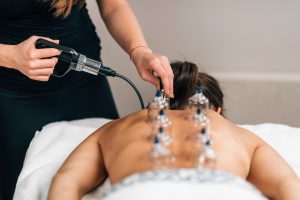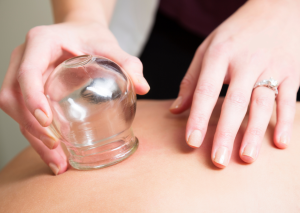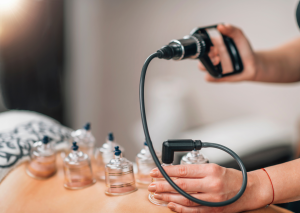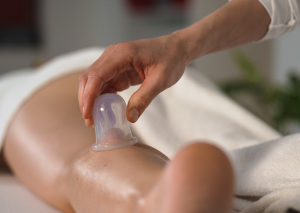Cupping Therapy: Increase Your Blood Flow
Cupping is an ancient therapeutic practice that involves creating suction on the skin using cups. This technique has been utilized for centuries in various cultures and is gaining recognition in modern healthcare. Cupping is thought to stimulate blood circulation, aiding in cellular repair and reducing muscle tension. The suction created during cupping lifts the skin and underlying tissues, contributing to increased flexibility by releasing fascial restrictions and reducing adhesions. Additionally, cupping may have anti-inflammatory effects, potentially offering relief for conditions characterized by inflammation. As an alternative therapy, cupping is often integrated into treatment plans to complement conventional approaches and promote overall well-being.




What is Cupping Therapy?
Cupping therapy is a practice that involves placing cups on the skin to create suction. This is a form of massage therapy that decompresses soft tissues to release tension and increase blood flow.
The Science Behind Cupping
Cupping works by creating suction on the skin, which stimulates blood vessels and improves circulation. This can help with cell repair and reduce muscle tension. The suction from cupping lifts the skin, fascia, and muscles, promoting flexibility by releasing restrictions and reducing adhesions. Cupping may also have anti-inflammatory effects, potentially providing relief for conditions with inflammation.
Benefits of Cupping Therapy
Cupping therapy offers a range of potential benefits, and while research is ongoing, many individuals report positive outcomes. It’s important to note that individual responses may vary, and cupping should be performed by trained professionals. Here are some of the potential benefits of cupping:
Improved Blood Circulation:
- Cupping creates a vacuum seal on the skin, promoting increased blood flow to the targeted area.
- Enhanced circulation delivers more oxygen and nutrients to the tissues, aiding in cellular repair and regeneration.
Muscle Tension and Pain Relief:
- Cupping is believed to help release tight muscles and fascia, reducing muscle tension and discomfort.
- It may be particularly beneficial for conditions like myofascial pain syndrome, where trigger points cause localized muscle pain.
Anti-Inflammatory Effects:
- Cupping may help reduce inflammation by increasing blood flow and promoting the movement of lymphatic fluid.
- This can be beneficial for conditions characterized by inflammation, such as arthritis and certain types of injuries.
Detoxification:
- Cupping is thought to stimulate the lymphatic system, aiding in the removal of toxins and waste products from the body.
- This detoxification process can complement the body’s natural cleansing mechanisms.
Improved Range of Motion:
- By reducing muscle tightness and promoting tissue flexibility, cupping may contribute to an improved range of motion in joints.
- This can be advantageous for individuals undergoing physical therapy for conditions affecting joint mobility.
Stress Reduction and Relaxation:
- Cupping therapy is often associated with relaxation and stress relief.
- The suction effect can help release endorphins, promoting a sense of well-being and relaxation.
Scar Tissue and Adhesion Reduction:
- Cupping may assist in breaking down scar tissue and adhesions, promoting tissue healing and reducing restrictions in movement.
- This can be particularly beneficial for individuals recovering from surgeries or injuries.
Enhanced Sports Performance and Recovery:
- Athletes often use cupping as part of their recovery regimen to address muscle soreness and facilitate quicker recovery after intense physical activity.
What Does Cupping Therapy Treat?
Cupping can be used to treat most musculoskeletal conditions. It can be used to treat lack of mobility, tight muscles, scars, and trigger points. It can address many diagnoses like back pain, headaches, tendonitis, bursitis, plantar fasciitis, fibromyalgia, and more.
What Does Cupping Therapy Feel Like?
Cupping may initially create a sensation of local pressure, pulling, or tightness as the tissue is pulled into the cup. There may also be a warm sensation due to increased local blood flow. These sensations usually dissipate quickly as the body relaxes and the tissue loosens.
Is Cupping Therapy Right for You?
Cupping Therapy is suitable for a wide range of individuals, including post-surgery patients, athletes, and those seeking to reduce pain and increase their range of motion. Our experienced physical therapists at ProFlex will evaluate your condition, medical history, and goals to determine if Cupping therapy is the right choice for you.
Schedule Your Appointment with a ProFlex!
If you’re ready to accelerate your recovery and achieve your rehabilitation goals faster, schedule an appointment with ProFlex today. Our experienced physical therapists will guide you through personalized strength sessions tailored to your unique needs.
Take the first step towards a stronger, healthier you by contacting ProFlex now. Your journey to enhanced muscle strength and faster recovery begins here.
